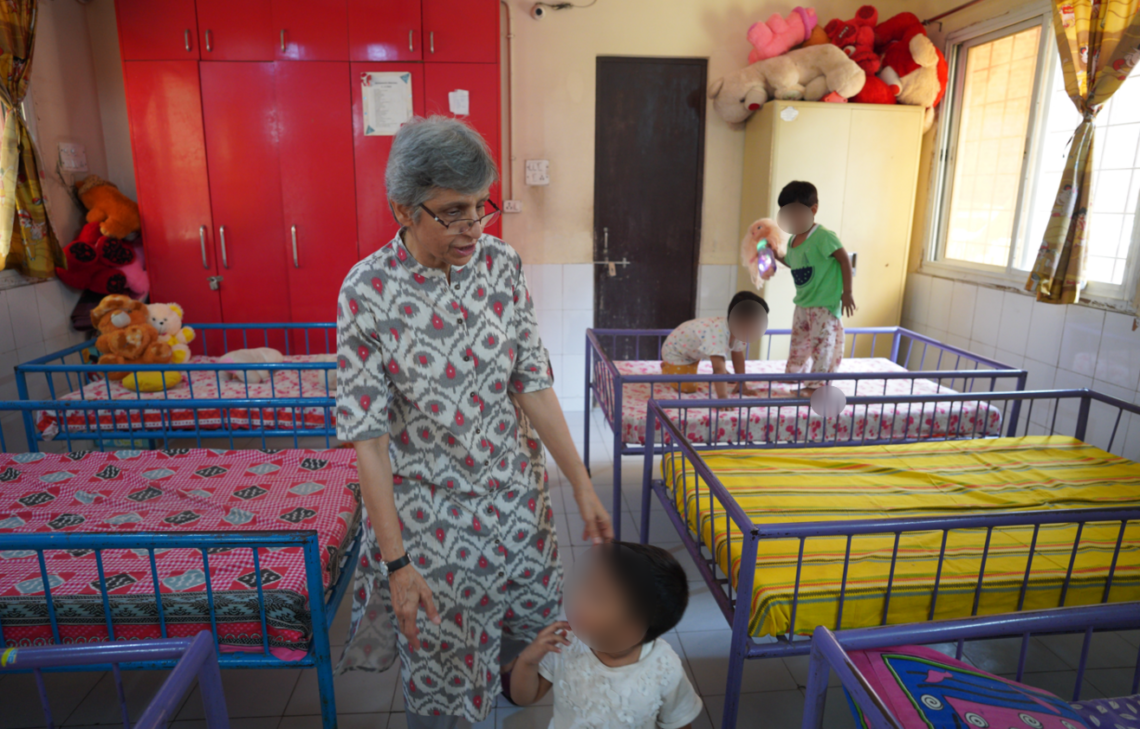Delhi Council for Child Welfare was established in the year 1952 by a group of 10 women.
The Council first started its work among children who had been displaced, lost, or abandoned in the riots surrounding the partition of India in 1948 by providing them with mid-day meals and recreational activities. Over the years, they saw the need for expansion and approached the government for a place to start a full time charity. The Government consented and gave them a small plot of land in Quadsia Bagh with two small rooms. In 1963, Delhi Council for Child Welfare (DCCW) was registered as a 100% charitable organization with Mrs. Rajan Nehru as president.
Its first and most well-known program is Palna, which is the Hindi word for cradle – a home for lost, displaced, and abandoned children till the age of 8. Palna prepares children for adoption by moulding their initial years of growth and development.
At the entrance of Palna, a cradle is placed on a wooden ledge in a small room. The weight of a baby placed in the cradle sounds an alarm. As this happens, a guard steps out to the sidewalk and stands watch while a nurse comes from Palna’s in-house clinic to take the baby in.
The cradle concept was introduced in the 1970s when newborns were being left at the doorstep. These infants belong to laborers who cannot afford their needs, or are born out of wedlock, or from families who do not value the girl child. Not every child is brought in by its parent/guardian. Many are brought in by the police, who find these babies abandoned at train stations, religious sites and other crowded areas.
When the children are brought in, they are first produced before the magistrate by Palna for registering under Child Council Welfare. This procedure is mainly followed so that there is a possibility of reuniting children to their families. “Sometimes people file a missing case. If the name and description on file matches the child staying with us, we reunite them with their families. A handful of children remember their parents’ phone numbers or home address. We help facilitate their return,” adds Ms. Sandhya Bhalla, who is the current director of the organization.
Palna consists of four dormitories – one each for older girls, older boys, infants and toddlers. There’s also a separate wing for children brought in who suffer from mentally disabilities; they receive special education here. The organization makes sure that its children get overall care; therefore it has a facility of a consulting pediatrician on call and two doctors round-the-clock to cater to the medical needs of the children.
During the day, teachers keep the children engaged through learnings, board games, singing and painting. There are 72 ayahs (caretakers) to take care of all the children. They also have a counselor who monitors the behavioral side of the children and 8 nurses who cater to the ill kids.
For over 6 decades, DCCW has been living up to its mission to “give children a childhood.” This is achieved through programs in the areas of health, nutrition, education and rehabilitation of physically and mentally challenged children, all of whom have been abandoned. Today, their services reach out to over 2,500 children in and around Delhi daily and are provided to them virtually free of cost. To support Delhi Council For Child Welfare:
Support Delhi Council for Child Welfare
–
Give’s mission is to “make giving bigger and better.” Give is the most trusted donation platform in India for fundraisers and crowdfunding campaigns. Through our technology solutions, we enable individuals and organisations to fundraise and donate to a cause, charity or NGO with trust and convenience. Give’s community of 2.7M+ individual donors and 300+ organisations supports 3,000+ verified nonprofits with 80G deduction and serves 15M+ people across India. Find a fundraiser today!

Give exists to alleviate poverty by enabling the world to give. Established in 2000, Give, together with its partners, is the largest and most trusted giving platform in India. Give enables individuals and organizations to raise and donate funds conveniently to any cause they care about, with offerings including crowdfunding, corporate giving, cause marketing, and philanthropy consulting. Give’s community of 2.6M+ donors supports 3,000+ verified nonprofits, serving 15M+ people across the country.
Discover more from
Subscribe to get the latest posts sent to your email.


You blog is enchanting and truly informative!